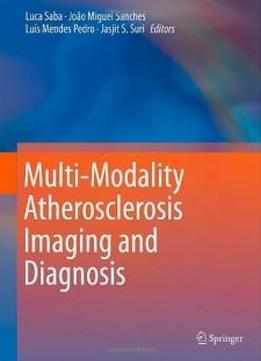
Multi-modality Atherosclerosis Imaging And Diagnosis
by Jasjit S. Suri /
2013 / English / PDF
15 MB Download
Stroke is one of the leading causes of death in the world,
resulting mostly from the sudden ruptures of atherosclerosis
carotid plaques. Understanding why and how plaque develops and
ruptures requires a multi-disciplinary approach such as
radiology, biomedical engineering, medical physics, software
engineering, hardware engineering, pathological and histological
imaging.
Stroke is one of the leading causes of death in the world,
resulting mostly from the sudden ruptures of atherosclerosis
carotid plaques. Understanding why and how plaque develops and
ruptures requires a multi-disciplinary approach such as
radiology, biomedical engineering, medical physics, software
engineering, hardware engineering, pathological and histological
imaging.Multi-Modality Atherosclerosis Imaging, Diagnosis and
Treatment
Multi-Modality Atherosclerosis Imaging, Diagnosis and
Treatment presents a new dimension of understanding
Atherosclerosis in 2D and 3D. This book presents work on plaque
stress analysis in order to provide a general framework of
computational modeling with atherosclerosis plaques. New
algorithms based on 3D and 4D Ultrasound are presented to assess
the atherosclerotic disease as well as very recent advances in
plaque multimodality image fusion analysis.
presents a new dimension of understanding
Atherosclerosis in 2D and 3D. This book presents work on plaque
stress analysis in order to provide a general framework of
computational modeling with atherosclerosis plaques. New
algorithms based on 3D and 4D Ultrasound are presented to assess
the atherosclerotic disease as well as very recent advances in
plaque multimodality image fusion analysis.
The goal of
The goal ofMulti-Modality Atherosclerosis Imaging, Diagnosis
and Treatment
Multi-Modality Atherosclerosis Imaging, Diagnosis
and Treatment is to fuse information obtained from different
3D medical image modalities, such as 3D US, CT and MRI, providing
the medical doctor with some sort of augmented reality
information about the atherosclerotic plaque in order to improve
the accuracy of the diagnosis. Analysis of the plaque dynamics
along the cardiac cycle is also a valuable indicator for plaque
instability assessment and therefore for risk stratification. 4D
Ultrasound, a sequence of 3D reconstructions of the region of
interest along the time, can be used for this dynamic analysis.
Multimodality Image Fusion is a very appealing approach because
it puts together the best characteristics of each modality, such
as, the high temporal resolution of US and the high spatial
resolutions of MRI and CT.
is to fuse information obtained from different
3D medical image modalities, such as 3D US, CT and MRI, providing
the medical doctor with some sort of augmented reality
information about the atherosclerotic plaque in order to improve
the accuracy of the diagnosis. Analysis of the plaque dynamics
along the cardiac cycle is also a valuable indicator for plaque
instability assessment and therefore for risk stratification. 4D
Ultrasound, a sequence of 3D reconstructions of the region of
interest along the time, can be used for this dynamic analysis.
Multimodality Image Fusion is a very appealing approach because
it puts together the best characteristics of each modality, such
as, the high temporal resolution of US and the high spatial
resolutions of MRI and CT.











